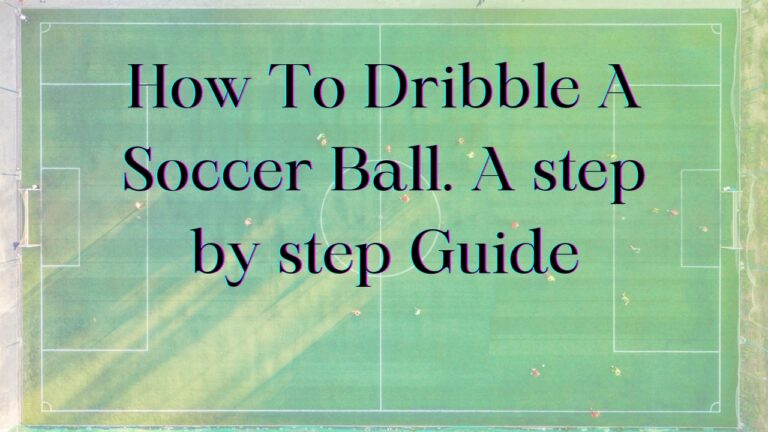Passing football efficiently is one of the fundamental skills every football player needs to master. Whether you’re a striker looking to set up a teammate to score or a defender moving the ball out of your end, crisp and well-timed passes are essential.
In this comprehensive guide, we’ll walk you through the key techniques and coaching points for the major types of passes in football. Master these methods through deliberate practice and you’ll have the passing ability to control the midfield and unlock defenses.
The Basics: Getting Into the Right Body Position
Before attempting any pass, you first need to get your body into the proper position over the ball:
- Plant foot placement: Place your non-kicking foot about one step length from the ball, pointing in the direction you intend to pass. Keep your plant leg bent for balance and stability.
- Body posture: Lean slightly forward from the hips, keeping your head up. Avoid bending too far forward or backward. Maintain balance and control.
- Kicking ankle locked: Keep a firm ankle on your kicking leg through contact with the ball. Don’t allow your ankle to roll or loosen up before or during impact.
- Eyes up: Continually scan the field to observe teammates’ positioning and movements. Keep your head up to spot passing lanes.
With this balanced and athletic base, you’re ready to deliver accurate passes. Now let’s break down the specific techniques.
Learn How To Pass Like Kelvin De Bruyne
The Push Pass: Go-To Pass for Short, Fast Ball Movement
The push pass is the most common and useful in football. It’s perfect for short, crisp ball movement to a teammate in a close passing lane.
Here’s how to perform the push-pass technique:
1. Approach the ball with your non-kicking foot pointed towards the target. Plant your foot next to the ball with your toes up.
2. Keep your knee over the ball, your body leaning slightly forward. Eyes scanning for passing options.
3. Strike the center of the ball with the inside of your kicking foot. Fully extend your leg through the ball.
4. Follow through towards your target with an elevated toe.
5. Focus on proper weight and accuracy for your teammate to receive the ball in stride.
Use the inside push pass to zip the ball rapidly over shorter distances. Its low trajectory and pace help it evade defenders. Practice push passing back and forth with a teammate to develop quickness, accuracy, and chemistry.
The Lofted Pass: Get Air Under the Ball
When you need to launch the ball over defenders’ heads or switch the field from one side to another, turn to the lofted pass. Here are the steps to send beautiful arcing passes:
1. Approach the ball at an angle. Plant your non-kicking foot pointed toward your target.
2. Raise your kicking leg straight back with a high, extended backswing.
3. Make contact with the bottom half of the ball using your shoelaces or instep.
3. Lean back slightly during the kick to get extra lift. Avoid over-leaning.
4. Follow through towards your target.
The lofted pass sacrifices pace for air time and distance. Practice gauging the right amount of power and lift for your teammates to run under the ball. Use this aerial pass to bypass pressure, spread the defense, or hit streaking strikers.
The Chip Pass: Maintain Ball Control in Tight Spaces
When navigating crowded midfield situations, reach for the chip pass to zip the ball between defenders’ legs. Here’s how it works:
1. Raise your kicking leg straight back to elevate the ball over the defense.
2. Make contact with the middle of the ball using your shoelaces.
3. Lean backward slightly during contact to get air underneath.
4. Follow through low towards your target.
The chip generates a backspin to bring the ball down quickly. This lets your teammate control it in tighter spaces. Use chips to split defenders or pass over slide tacklers. Practice varying the height and spin for optimal control.
The One-Two Pass: Quickly Get Behind Defenders
If a single defender steps up to challenge you, beat them with the give-and-go one-two pass. Just make sure you and the teammate are on the same page:
1. Push pass to your teammate then immediately make a run behind the defender.
2. Signal to your teammate when you’re ready for the return pass.
3. Sprint into the open space to receive the ball and continue your attack.
This rapid exchange stretches defenses by getting an attacking player behind the defense instantly. Refine your one-two choreography and timing through regular repetition with your attacking partners. Soon defenders won’t know how to contain you!
Learn How To Pass Like Kelvin De Bruyne
Continue Sharpening Your Passing Skills
As you can see, football features a diverse passing toolkit for navigating different in-game scenarios. But without practice, even the best techniques fall short.
Aim to perform at least 100 passes per day using the various methods above. Vary the types, distances, heights, and targets. As you gain consistency, do passes on the move and against simulated pressure. Soon you’ll have the passing vision and precision to pick apart any defense!
Take Your Passing to the Next Level
Once you’ve mastered the core passing techniques and can consistently deliver accurate balls, it’s time to advance to more dynamic and game-like scenarios. Here are some ways to challenge yourself:
Pass on the move – Rather than passing stationary, sell defenders with a fake run then pass on the dribble. Or pass while checking your run to get open again. Master these passing movements.
Play wall passes – Pass to a teammate then make a checking run around them to receive the immediate layoff. This is great for getting behind defenses.
Pass under pressure – Have a teammate defend you while you attempt passes. Vary the direction and angle of the pressure. Focus on quick decisions and technique.
Receive and distribute – Set up stations where you must control a passed ball and then instantly distribute with your first touch—stress speed of play and scanning.
Try no-touch passing– One-time passes without controlling the ball first. Great for fast transitions and catching defenses off guard. Requires precision and timing.
Play small-sided games – 4v4 and 5v5 games with small goals test your passing. Enlist your teammates’ help in defending and finding space. Implement what you drill in competitive environments.
Troubleshooting Your Passing Problems
Even seasoned players struggle with their passing at times. Here are some common challenges and solutions:
Inconsistent accuracy – Go back to basics of body shape, plant foot placement, and ankle lock. Prioritize precision over power.
Telegraphing passes – Vary tempo, disguise passes at the last moment. Scan more to spot open teammates earlier.
Getting passes intercepted – Make quicker decisions, and move the ball faster. Ensure teammates are engaged and actively supporting.
Unable to complete one-twos– Synchronize movements with verbal and non-verbal communication. Show for returns earlier and more assertively.
Struggle to receive passes – Move to balls rather than waiting. Get in line with the ball’s path. Improve the first touch using various body parts to cushion.
Take Your Passing Practice On the Road
Don’t limit your passing practice to formal team training sessions. Bring a ball with you and get creative with passing workouts in everyday situations:
Pass against garage doors or brick walls – Quickly move to passes and test your first touch gathering errant rebounds. Vary height and spin on returns.
Pass with family members – Get parents, siblings, or kids involved, even if they’re not soccer players. Start slowly progressing with speed and movement.
Pass to yourself off kickboards – Ripple glass basketball backboards often found at schools provide unpredictable bounces to hone the first touch.
Pass against curb edges – Chip passes off the edge of grassy curbs or sidewalks for unpredictable bounces. Chase down each pass.
Try futsal – This mini-football variant played on hard courts develops quick floor passing and improvisation in tight areas.
Getting inventive with passing practice outside of traditional field sessions accelerates development since you can do it daily. Don’t underestimate the benefits of passing against novel surfaces and environments.
Continue Your Passing Education
Even when you’ve elevated your passing to an elite level, keep expanding your knowledge and range:
Study modern passing tactics – Master newer strategies like the third-man combination pass or the no-look dummy pass and its variants.
Observe top passers and mimic their methods – Break down what makes superstars like Modric, De Bruyne, and Kroos so precise. Copy their approach angles, passing foot preferences, and disguises.
Experiment crossing with both feet – Ambidextrous players offer unpredictability in the attack. Get proficient at whipping crosses from the left, right, and on the dribble.
Attempt more long-distance passes – Hoofing deep balls over 60-70 yards requires refined technique. Bend shots from deadball situations.
football passing technique evolution continues, so players must keep educating themselves. We hope these tips inspire you as you continue your improvement!
Here’s more content to continue expanding the football passing skills blog post:
Make Passing Work for You in Any Position
While accurate passing ability benefits all players, you can tailor technique and practice to maximize impact in your specific position:
Striker: Master killer through passes to beat the offside trap. Score by passing into open nets when defenders close down. Redirect crosses with various surfaces.
Winger: Spin early crosses off 1/2 step preparation touches. Fire low diagonal balls from the touchline across the box. Learn to cut inside and link play.
Attacking mid: Dictate tempo from the half-spaces. Switch the point of attack. Execute final line-splitting passes—score from a distance with driven shots.
Central mid: Develop 360-degree passing range and vision. Recycle possession under pressure. Form triangles and diamonds to maintain control.
Fullback: Drill long switches to the opposite flank. Whip near post crosses off overlaps. Time over/underlapping runs for interplay with wingers.
Center back: Ping diagonal balls to stretch teams vertically and horizontally. Initiate counterattacks through crisp outlet passes.
Keeper: Roll or throw crisp outlet passes to floor-oriented teammates. Learn to move possession under pressure. Attempt long goal kicks.
As you can see, truly skilled passing unlocks new dimensions for every position’s role. Isolate your position-specific needs and incorporate targeted drills into your practice routine. soon you’ll expand your options and reliability in that space on the pitch.
Conclusion & Final Takeaways
Passing remains football’s most important skill – the fuel powering attacks and the foundation maintaining possession. While natural talent provides a head start, any player can refine technique through dedicated work.
Incorporate the tips in this guide into a regular training regimen. Seek further learning opportunities from books, videos, and coaching mentors. Brainstorm new drills that test your skills.
Related Post: Learn How To Pass Like Kelvin De Bruyne






